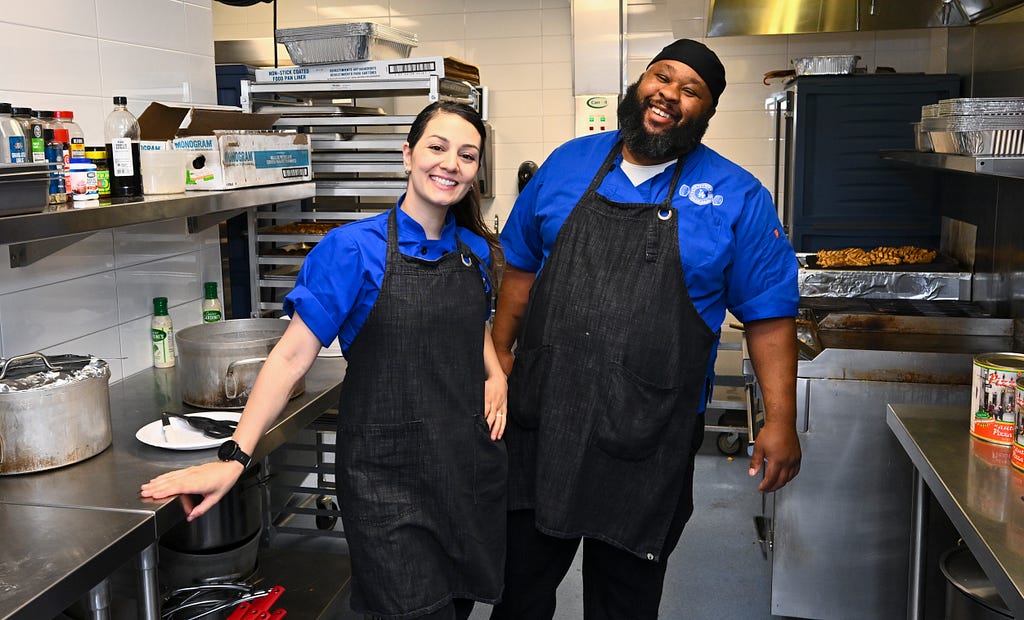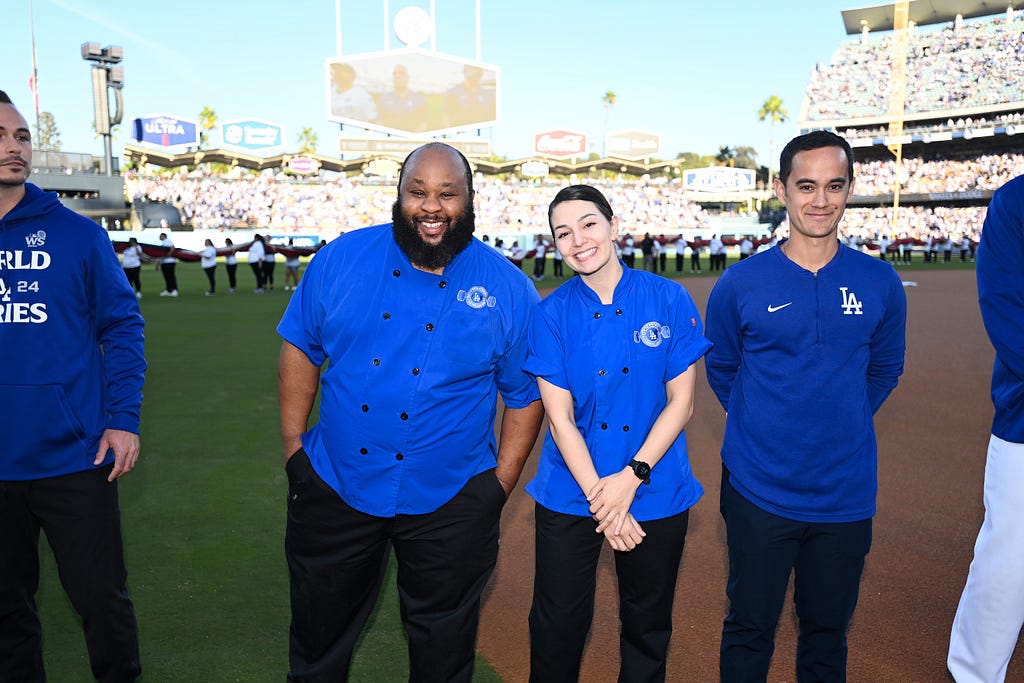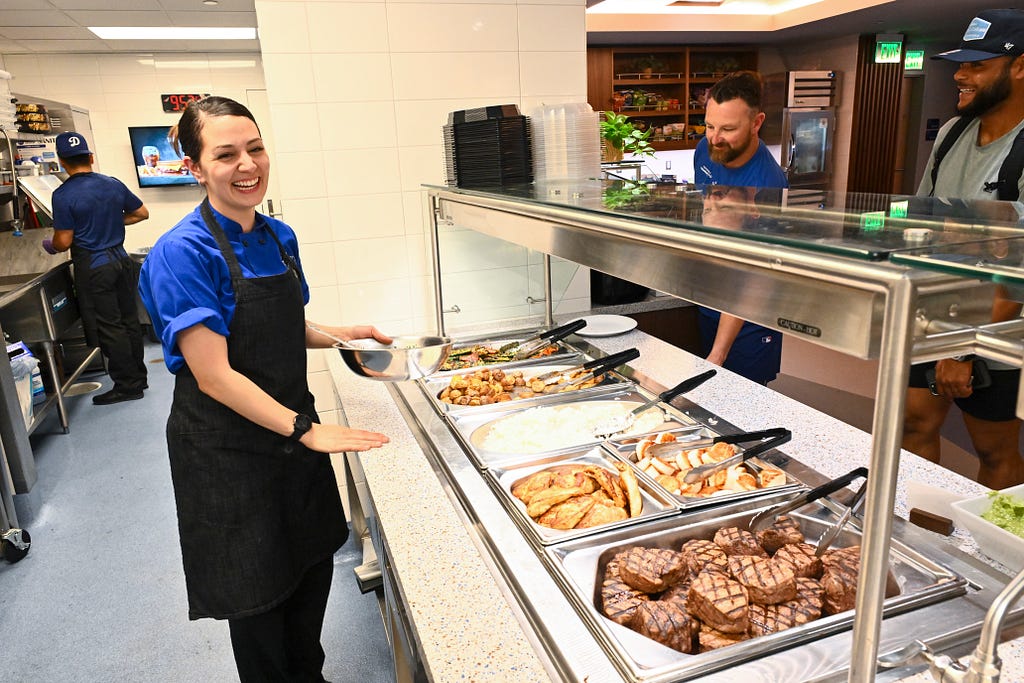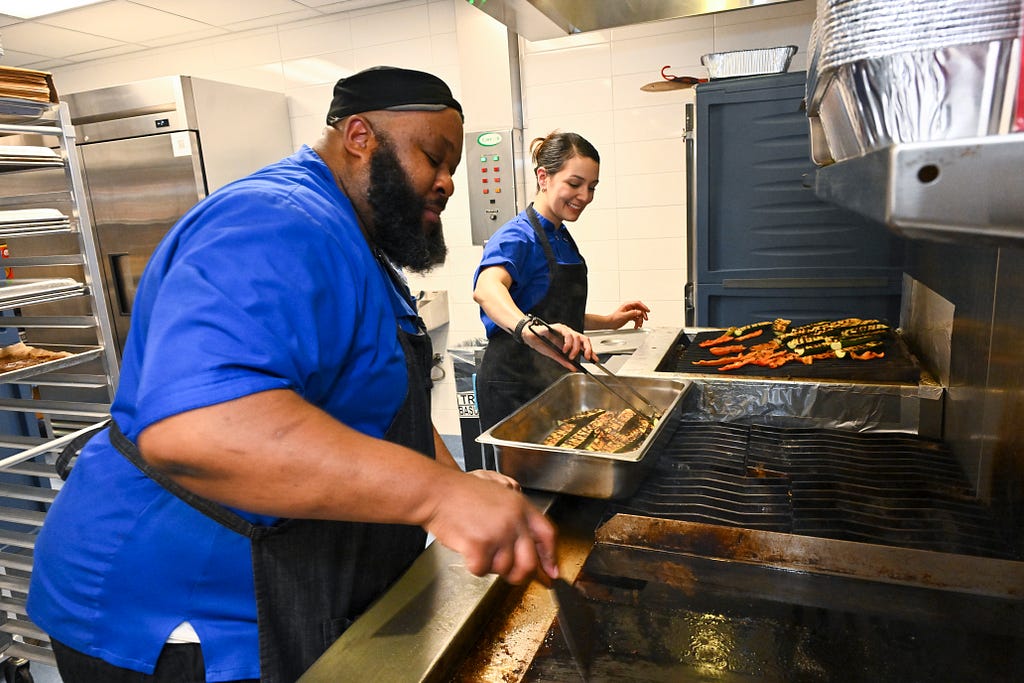From Dodger Insider magazine: The Home Plate Keepers
Dodger chefs are helping to fuel a championship squad

By Megan Garcia
The smell of eggs, bacon and potatoes keeps the Dodgers’ head chefs from dozing off in the wee hours of the morning. They’ve mastered the morning routine down to a tee for a day game at Dodger Stadium: sleep a couple of hours, pick up boxes of donuts, then prepare 240 pounds of protein.
Feeding a professional baseball team is an art and a science. There are two masterminds in the Dodger clubhouse kitchen that strike the balance between concocting new recipes and factoring in macronutrients throughout the year.
Kristen DeCesare, Dodger head performance chef, and Tyrone Hall, Dodger performance nutrition manager, have dedicated their careers to the culinary science of fueling an athlete. It may not be launch angles that they’re analyzing, but the cooking duo has a part in assembling a winning team on the field.
“It’s more about providing the building blocks that they need to do what it takes to get back out on the field,” Hall says. “Sometimes it’s not necessarily about having a specific dish but making sure that you have two to three proteins, two different carbohydrates (and) two different vegetables on top of that.”

The days of bologna sandwiches, chicken tenders and hot dogs sprawled out on a table by a clubhouse attendant in the 1950s are long gone. Now it’s a methodical process that starts in the early days of Spring Training. The pair learns the intricacies of each player’s diet and caters to it throughout 162 games and the postseason.
Every meal the players eat is planned by DeCesare and Hall. From breakfast to dinner at Dodger Stadium, from the flights to road games — every crumb gets their stamp of approval.
“We basically build (the menu) in an Excel spreadsheet,” DeCesare says. “We’ll go day by day, lunch, post (batting practice), dinner. We also do two meals for the umpires. We’ll always start with proteins for the most part and say, ‘What haven’t we made in a while?’”

Each day is sectioned off by mealtimes and color-coded. Lunch is usually the first meal of the day, with players arriving in the early afternoon for night games. They counter-balance the heaviness of the meals so players aren’t induced into food comas before they take the field.
The easiest menu (in terms of ingredients) to build — yet also the most difficult (in terms of thought) — is the post-batting practice meal. The pregame meal needs to be nutritionally balanced to fuel players for nine innings or more. Grilled chicken, rice and vegetables are staples in the clubhouse dining room.
While meals are health-conscious, there is room for DeCesare and Hall to spice things up.
Variety is important when feeding an army, or in this case, dozens of players, coaches and Dodger personnel staff. The daily menus are themed to keep the selection fresh — like taco Tuesdays, burger bars and sushi Fridays. It’s how they cover their bases by incorporating a protein, a vegetable and the team’s various cultures.

“It’s a really important balance that they create between the stuff that we need and the stuff that we want,” says veteran infielder Miguel Rojas. “Having 26 players every single day, plus the coaches and all that, it’s really hard to put a meal together that everybody’s happy with. But they do a really good job of changing (the menu) and knowing what the players want and giving you options that are healthy for you and what’s going to help you perform better.”
There’s been a nutrition revolution in the past decade. Hall noticed the shift started when players with collegiate backgrounds expressed the need for healthier and fresher meal options. Those players worked with their university’s nutrition department and learned the benefits of a healthy diet.
So little by little, the candy, fried chicken and sodas were replaced by wheatgrass shots, green juices and salad bars. Those feel-good grubs turned into performance-boosting meals. The energy they were exerting in a game was finally being replenished.
Having been in the Major Leagues for 12 seasons and having played for two organizations, Rojas says he has seen a difference in how food is served in the clubhouse.
“Teams are spending so much money and putting the time into understanding what really is going to help you not just to perform on the field, but keep you happy off the field as well,” Rojas says. “When I got to the league, the food was still really good, but it was a lot of catering from places around the stadium.”
Rookie catcher Dalton Rushing says, in his experience, the old peanut butter and jelly sandwich being the Minor League staple was not the case. The Dodgers’ dedication to forming a well- rounded player doesn’t just begin at the Major League level.
“It’s the best of the best. They cater to you. It’s whatever you like, and it’s a blessing,” Rushing says. “In the Minors, we have chefs with the Dodgers. That’s kind of a step up higher than every other Minor League system. We had chefs who traveled around with us.”

When the Dodgers hit the road, DeCesare and Hall remain at Dodger Stadium.
They brainstorm the menus for the upcoming homestand as they tear open produce boxes and restock the pantry. They’ll yell out ideas and scribble down action items on a cardboard box for the subsequent homestand. It’s a to-do list where knife rack orders, green tea ice cream and cleaning out the grease trap can co-exist.
“The Dodgers do a really good job of finding the best of everything. Tyrone and Kristen are the best at what they’re doing.” Rojas says.
The culinary operation is constantly moving until the last out of the season is recorded.
The euphoric wins and heartbreaking losses affect them the same way as the players. During their partnership, they’ve ridden the rollercoaster of emotions of early postseason exits and World Series titles. They both grew up as big sports fans — DeCesare in Rhode Island and Hall in North Carolina. So to be a part of the Dodgers’ big picture isn’t lost on them.
The menu possibilities are endless, but the goal is always the same — the fruits of victory.
From Dodger Insider Magazine: The Home Plate Keepers was originally published in Dodger Insider on Medium, where people are continuing the conversation by highlighting and responding to this story.
